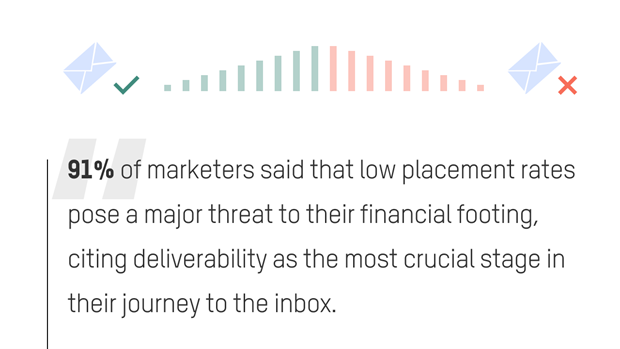Not all emails sent by marketers reach their subscribers’ inboxes. Some get blocked, some get marked as spam, some don’t get delivered at all. There are many factors that affect email campaigns’ deliverability—email infrastructure, sender reputation, IP address, recipient behavior, and so on. For marketers concerned with the bottom line, it’s important to determine which areas are keeping them from reaching their audience’s inboxes.
Based on World Research Advertising Center’s (WARC) report, 91% of marketers said that low placement rates pose a major threat to their financial footing, citing deliverability as the most crucial stage in their journey to the inbox. Here are some practical tips to ensure your campaigns arrive at their intended destinations and keep your efforts profitable.

Stack a defense
Some senders tend to overlook the importance of using email authentication protocols in their email strategies. When email domains are not authenticated, they wind up undelivered, spammed, or banned from subscribers’ inboxes. Most internet service providers (ISPs) automatically tag unverified emails as malicious messages, blocking them at the gateway. So if your email domain is not authenticated, chances are your campaigns will end up getting blocked.
Indeed, email authentication is an effective strategy in combating potential attacks, such as phishing, spamming, and fraud. But aside from keeping cybercriminals at bay, this authentication protocol also helps reduce potential email deliverability issues. If you want your campaigns to land in the inbox, then capitalize on different authentication tools available in the market. There are numerous authentication protocols that senders can use, like Sender Policy Framework (SPF), which prevents unpermitted parties from using senders’ domains.
There’s also the DomainKeys Identified Mail (DKIM), which is used to validate emails by imprinting cryptographic signatures onto them. Meanwhile, Domain Message Authentication Reporting and Conformance (DMARC) is a new authentication tool that protects senders from email spoofing. Unlike SPF and DKIM, DMARC serves as a supplemental authentication mechanism and must be integrated with other techniques.
Give it a tune-up
Some might not be aware that the volume of delivered emails can affect their inbox placement rates. For senders with new dedicated IP addresses, it’s crucial to warm them up before anything else. Experts recommend starting with a low volume of campaigns before blasting audiences with a high volume of emails. This is especially true for senders aiming to deliver more than 50,000 emails each month.
This process of warming up is important to avoid being marked as suspicious by ISPs. This slow increase in email volume gives ISPs the chance to assess sender reputation before giving them a nod. Experts suggest sending no less than 500 emails in the first week, then increasing them the following weeks. By following this warmup period, senders can expect fewer message delays or deliverability problems in the long run. Furthermore, senders can achieve their maximum placement rates by following this practice.
Make it double
Sending emails to users who didn’t sign up for them (or were unaware that they did) can have a negative impact on your deliverability rates. Doing so can increase complaints and spam reports against your email domain and prompt ISPs to ban you from delivering more messages to other users. If you’re noticing a drop in your placement rates, consider refining your opt-in process.
In a report from Email Marketing Benchmark, 61% of today’s senders utilize single-opt techniques to capture leads. However, experts suggest that double-opt-ins is the most ideal form of requesting email consent. This is a two-step subscription process in which businesses send email confirmations to users to finalize sign-up. While it’s more difficult to grow contact lists using this technique, it does help marketers capture a better quality of recipients, reduce user complaints, and maintain a positive sender reputation. Furthermore, using double-opt-ins is more adherent to universal data regulation policies like General Data Protection Regulation (GDPR).
Cut the frills
Aside from enhancing your sign-up method, it’s also necessary to improve your unsubscribe process to see an improvement in inbox placement rates. Senders must make it convenient for subscribers to withdraw their consent as this could affect their sending reputation, and in turn, reduce their email deliverability at large. It’s best to make opt-out a one-click process to reduce user pain points.
In addition, simplifying the unsubscribe process helps make senders more legally compliant. According to GDPR guidelines, senders must make opt-out simple and not require additional information from users to withdraw their subscriptions. They also shouldn’t log in to their accounts or be redirected to another site just to confirm their opt-out. These measures not only ensure senders’ legal compliance but also guarantee better placement rates for businesses.
Scrub it clean
There’s no use in keeping inactive subscribers on your contact list. The truth is, keeping unengaged recipients will do more harm than good to your email performance. Continuously sending campaigns to uninterested subscribers can cause a spike in your spam complaints and reduce the overall deliverability of your emails. This can lead to a bad sender reputation, making it more difficult for you to reach active users’ inboxes. By cutting down your list, you can generate more accurate numbers across metrics. Furthermore, marketers can reduce costs and resources. No efforts will go to waste with an updated list.



